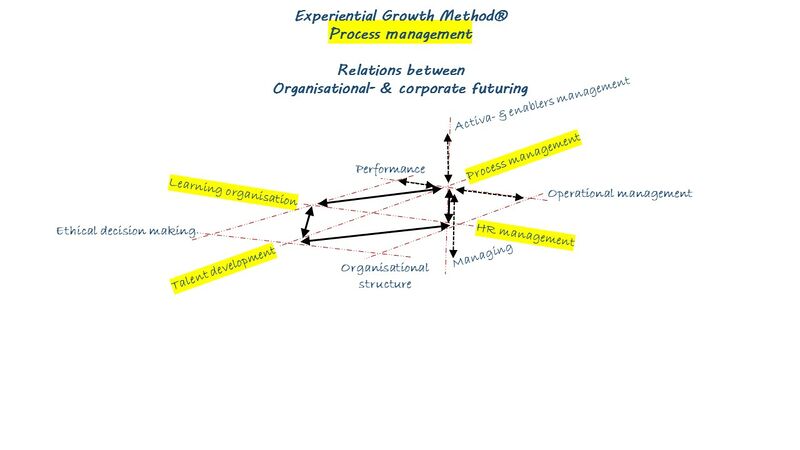Process management
Chapter 3 - Experiential Growth Method® - Deeper dive - Action field
Back to Action fields or Book content
.
Welcome to the Process management page
.
What is process management?
The term process comes from the Latin word processus or procession, which translates as a performed action of something that is done and how it is done. Therefore, a process is a collection of interrelated tasks and activities that are initiated in response to an event that aims to achieve a specific result for the consumer of the process.
A business process is a collection of tasks and activities (business operations and actions) consisting of
- employees, through HR managment, Talent development & Learning organisation
- materials & machines, through Activa- & enablers management
- systems, and methods, through Managing
that are being structured in such a way as to design, create and deliver a product or a service to the consumer.
.
Thinking about the concept
A visual thesaurus search is always an excellent starting point to discuss a concept definition:
| Thesaurus - ENG |
|---|
| Thesaurus - Synonyms, Antonyms, and Related Words (freethesaurus.com) |
.
.
Relations of Process management within Organisational futuring (and Corporate futuring)
.
.
There exists a close vertical relationship within Organisational futuring:
- Outer focus: Activa- & enablers management
- Other focus: Process management
- Inner focus: Managing
.
On the Other focus level, a close relationship exists with:
- HR management
- Talent development
- Learning organisation
.
Corporate futuring and Organisational futuring intertwine, on the Other focus level, through:
- Operational management
- Organisational structure
- Ethical decision making
- Performance
.
In concrete terms, this means:
- The trio - 'Managing', 'Process management' and 'Activa- & enabalers management' - is inextricably linked.
- Your 'Process management' contributes substantially to 'HR management', 'Talent development' and 'Learning organisation'.
- Furthermore, 'Process management' is part of the Other focus level where 'Organisational-' and 'Corporate futuring' meet.
.
.
Questions we can ask ourselves when contemplating our Process management
- Supports our 'Process management' our 'Learning organisation', our 'Talent management' and our 'HR management'?
- Are our processes based on management standards?
- Is our 'Process management' robust enough to generate a vialble 'Activa- & enablers management'?
- Is our 'Process management' keen enough to support 'Performance' and 'Operational management'?
- Is our 'Process management' a collider or a mediator between our 'Learning organisation' and our 'HR management'?
.
.
Working with Process management in relation to other departments in the organisation
Describing your business processes will provide you with advantages
- It is a means for taking under employees, colleagues and (senior) management about change, investment, adjustments, reasons why mistakes happen, etc., without having to unwind any negative emotions.
- It helps you to create a better understanding of what your customers really want.
- It increases your understanding of the workings of your business.
- It helps you to develop (further) a professional management system.
.
What are business processes?
Business processes realise your goals together with your employees and the installed infrastructure:
- A business process is a series of strongly interconnected tasks.
- Each task has at least one input and at least one output and executed by one function (role).
- A function (role) is performed by an employee or by a team of employees.
- Each task has at least one input and at least one output and executed by one function (role).
- Every business process has one objective which directly contributes to the strategic goals of your Business Unit (eg. invoices sent, trucks loaded, drivers trained, …).
- From each process you can derive a good Key Process Indicator.
- From each process you can pinpoint a good Key Performance Indicator.
- From each process you can derive a good Key Process Indicator.
.
You can structure processes according to their nature
- Value-adding processes, (also called core processes).
- Processes for which the customer really wants to pay.
- Supporting processes.
- Necessary processes to realize the value-adding (core) processes.
- Other business processes.
- These are business processes that currently neither contribute to business objectives, nor are supportive.
.

